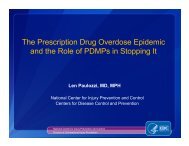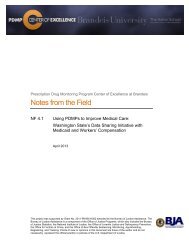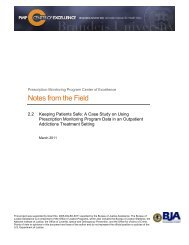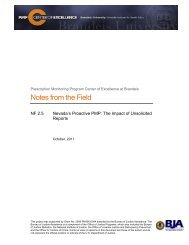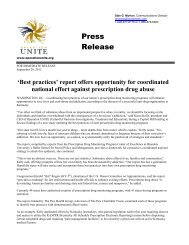Prescription Drug Monitoring Programs - PDMP Center of Excellence
Prescription Drug Monitoring Programs - PDMP Center of Excellence
Prescription Drug Monitoring Programs - PDMP Center of Excellence
Create successful ePaper yourself
Turn your PDF publications into a flip-book with our unique Google optimized e-Paper software.
<strong>Prescription</strong> <strong>Drug</strong> <strong>Monitoring</strong> <strong>Programs</strong>: An Assessment <strong>of</strong> the Evidence for Best Practices 40the federal certification to accept and enroll users in their <strong>PDMP</strong>s, thus saving the prescriber fromduplicative authentication procedures and expediting the <strong>PDMP</strong> enrollment procedure. This kind <strong>of</strong>study is urgent as e-‐prescribing <strong>of</strong> controlled substances is expected to advance quickly, especially asNew York State has passed a 2012 statute mandating e-‐prescribing <strong>of</strong> controlled substances within a fewyears.Barriers to adoption: Barriers to streamlining certification and enrollment processing include lack <strong>of</strong>secure online information systems that can replace in-‐person notarization as a means to authenticateapplicants. In particular, the need exists to explore federal certification <strong>of</strong> prescribers to issue electronicprescriptions for controlled substances, as a shortcut in state authentication systems.SummaryRationale: Streamlined certification and enrollment processes may increase enrollment and utilization.Evidence <strong>of</strong> effectiveness: Accumulated experience, key stakeholder perceptions.Current adoption status: A few states have explored various steps in streamlining enrollment.Barriers to adoption: Lack <strong>of</strong> information systems and validated processes that would facilitatecertification and enrollment, including possible use <strong>of</strong> federal certification <strong>of</strong> prescribers for electronicprescribing.4. Mandate enrollmentRationale: In most states with operational <strong>PDMP</strong>s, enrollment and utilization are voluntary. This makesit necessary for states to conduct recruitment campaigns to increase awareness <strong>of</strong> the <strong>PDMP</strong> and induceprescribers and pharmacists to enroll (see 2. Conduct recruitment campaigns, above). Such campaignscan be expensive, resource-‐intensive, and time-‐consuming; <strong>PDMP</strong> administrators frequently report thatcampaigns fail to produce high rates <strong>of</strong> participation. Another option, not yet widely adopted butgaining in prevalence, is to make enrollment in a <strong>PDMP</strong> mandatory for certain user groups, such asprescribers and dispensers (NAMSDL, 2012a).Evidence <strong>of</strong> effectiveness: The effectiveness <strong>of</strong> prescriber-‐‐ and pharmacist-‐mandated enrollment inproducing greater utilization <strong>of</strong> <strong>PDMP</strong>s needs to be assessed, taking into account any unintendedconsequences, such as resistance on the part <strong>of</strong> some doctors to a perceived regulatory burden and/orinfringement on their autonomy, or the inability <strong>of</strong> enrollment and certification systems to handle a surge<strong>of</strong> applications. One <strong>PDMP</strong> has expressed concern about a legislative mandate for enrollment because itmay not provide funding for processing applications. Examining states’ experience could shed light onwhether mandates are more successful than voluntary campaigns in producing high rates <strong>of</strong> enrollmentand utilization, and if so, which ancillary systems and policies enable successful mandates. Utah, with arelatively small number <strong>of</strong> prescribers, has been able to implement mandated enrollment using itsadvanced health management information system. How and whether larger and less technologicallyadvanced states could carry out such a mandate are open questions needing investigation.Current adoption status: Since 2007, Arizona has required that practitioners who possess a registrationunder the U.S. Controlled Substances Act must also be registered with the <strong>PDMP</strong>. Utah has recently (July



